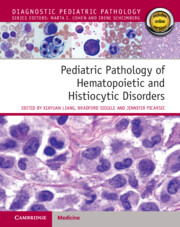Book contents
- Pediatric Pathology of Hematopoietic and Histiocytic Disorders
- Pediatric Pathology of Hematopoietic and Histiocytic Disorders
- Copyright page
- Epigraph
- Contents
- Contributors
- Section I General Hematology and Hematopathology
- Section II Non-Neoplastic Hematologic Disorders of Blood and Bone Marrow
- Section III Non-Neoplastic Disorders of Extramedullary Lymphoid Tissues
- Section IV Neoplastic Disorders of Bone Marrow
- Section V Mature Lymphoid Neoplasms
- Section VI Histiocytic Disorders and Neoplasms
- Chapter 24 Histiocytic Pathogenesis and Derivation
- Chapter 25 Identification of Macrophages and Dendritic Cells
- Chapter 26 Non-Neoplastic Accumulation of Histiocytes
- Chapter 27 Hemophagocytic Lymphohistiocytosis (HLH)
- Chapter 28 Histiocytic Inflammatory Neoplasms/Lesions
- Index
- References
Chapter 25 - Identification of Macrophages and Dendritic Cells
from Section VI - Histiocytic Disorders and Neoplasms
Published online by Cambridge University Press: 25 January 2024
- Pediatric Pathology of Hematopoietic and Histiocytic Disorders
- Pediatric Pathology of Hematopoietic and Histiocytic Disorders
- Copyright page
- Epigraph
- Contents
- Contributors
- Section I General Hematology and Hematopathology
- Section II Non-Neoplastic Hematologic Disorders of Blood and Bone Marrow
- Section III Non-Neoplastic Disorders of Extramedullary Lymphoid Tissues
- Section IV Neoplastic Disorders of Bone Marrow
- Section V Mature Lymphoid Neoplasms
- Section VI Histiocytic Disorders and Neoplasms
- Chapter 24 Histiocytic Pathogenesis and Derivation
- Chapter 25 Identification of Macrophages and Dendritic Cells
- Chapter 26 Non-Neoplastic Accumulation of Histiocytes
- Chapter 27 Hemophagocytic Lymphohistiocytosis (HLH)
- Chapter 28 Histiocytic Inflammatory Neoplasms/Lesions
- Index
- References
Summary
The appearance and phenotype of histiocytes can change with levels of maturation, activation, and the local tissue microenvironment, with only a few markers truly constitutive. Widely varying surface and cytoplasmic molecules are informative for these cells and are easily identified using flow cytometry, although many are not unique to these cell lines. Others are more useful for the identification of macrophages, dendritic cells, and their neoplastic counterparts in fixed tissues. Table 25.1 lists some antibodies informative for histiocytes by flow cytometry, only some of which are restricted to either macrophages or dendritic cells; many are common to both. Table 25.2 lists the common types of monocyte/macrophage and dendritic cells and the markers most useful in their identification in fixed tissues (1). Chapter 28 further highlights immunostain panels best adapted for neoplastic proliferations.
- Type
- Chapter
- Information
- Pediatric Pathology of Hematopoietic and Histiocytic Disorders , pp. 310 - 311Publisher: Cambridge University PressPrint publication year: 2024

